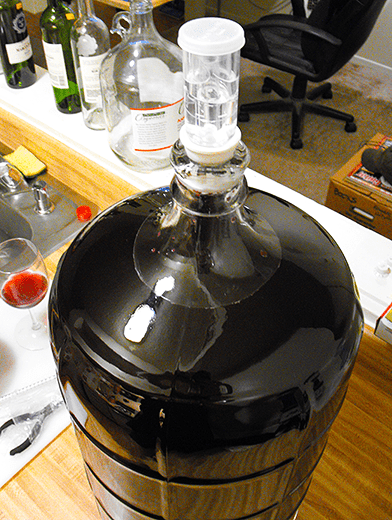 Ed, I was looking for answers for when a malo-lactic fermentation is completed and came across your [malolactic fermentation] article. This is the first time I have used fresh grapes for making wine. I have 15 gallons in 3 five gallon carboys right now. I bought the malo- lactic culture at my local supply shop, they knew what kind of wine I was making. You stated in your article that malo-lactic fermentation should not be done to zinfandel wine….that’s what I am making. Did I screw up?
Ed, I was looking for answers for when a malo-lactic fermentation is completed and came across your [malolactic fermentation] article. This is the first time I have used fresh grapes for making wine. I have 15 gallons in 3 five gallon carboys right now. I bought the malo- lactic culture at my local supply shop, they knew what kind of wine I was making. You stated in your article that malo-lactic fermentation should not be done to zinfandel wine….that’s what I am making. Did I screw up?
John F. — OH
—–
Hello John,
To say a malolactic fermentation ruined your wine is a bit of an over-statement. As I recall, the point I was trying to get across in the article about malolactic fermentation is that not all wines will benefit from a MLF, and in fact, some wines will not improve because of it, but may even become worse.
This does not mean that the wine will taste bad or be undrinkable. Barring any other faults in the wine, my guess is it will still be quite nice… it’s just that it probably could have been better.
I have never tasted a Zinfandel that has gone through a malolactic fermentation, so I do not know the potential results with any certainty. I am only going by what I see in the market, traditionally, and my imagination as to what it might taste like.
One of the stronger characters of any Zinfandel is its jammy/berry qualities. It’s what has made the Zinfandel grape so popular. This quality is much more prevalent in this grape than any other grape I can think of. It is what a Zinfandel drinker has come to expect from this type of wine. A malolactic fermentation will reduce this particular character of the Zinfandel. It will reduce the assertiveness of the berry flavors and bring it more towards earthy and rich. This would be OK if you are looking for the rich, earthy tones of a Burgundy, but with a Zinfandel you’re not. You are looking to showcase the perceived opposite — fruity and assertive..
 If you have just introduced the wine with the malolactic culture, you still have a choice. Malolactic bacteria is very sensitive to sulfites. That is to say, you can treat your wine with a single dose of either: Campden tablets, potassium metabisulfite or sodium metabisulfite to stop the malolactic fermentation. No harm, no foul.
If you have just introduced the wine with the malolactic culture, you still have a choice. Malolactic bacteria is very sensitive to sulfites. That is to say, you can treat your wine with a single dose of either: Campden tablets, potassium metabisulfite or sodium metabisulfite to stop the malolactic fermentation. No harm, no foul.
Another thought is since you have three carboys going, maybe you could stop the malolactic fermentation in two of them and let the third one go. This would only be if you were interested in having better understanding of what a malolactic fermentation does to a wine. If you really don’t care and do not want to give up 5 gallons “to science”, then add sulfite to all three.
I hope this information helps you out and help you to understand why the malolactic fermentation did exactly ruin your wine. I know that everything I’ve said is not 100% definitive. This is because we are talking about wine. Everyone’s perception of it is different. For example, it is possible that you will like the Zinfandel that has gone malolactic fermentation better than that which has not — not likely, but possible. I can only go by what my personal taste are and what I have learned to be the tastes of most others. For this reason, don’t take my words as gospel. Take them as some practical advice.
Happy Wine Making,
Ed Kraus
—————————————————————————————————————–
Ed Kraus is a 3rd generation home brewer/winemaker and has been an owner of E. C. Kraus since 1999. He has been helping individuals make better wine and beer for over 25 years.
